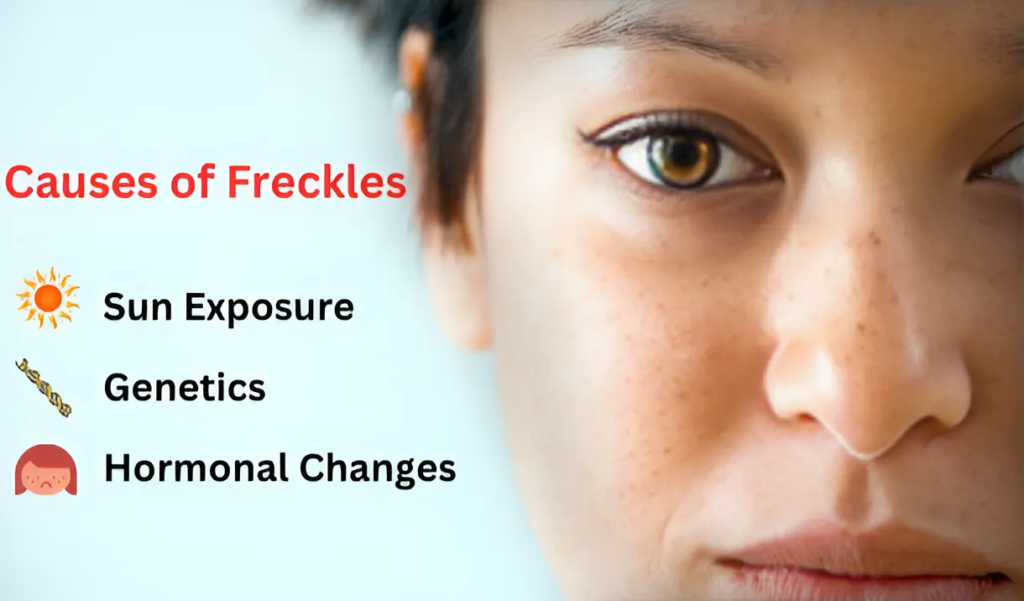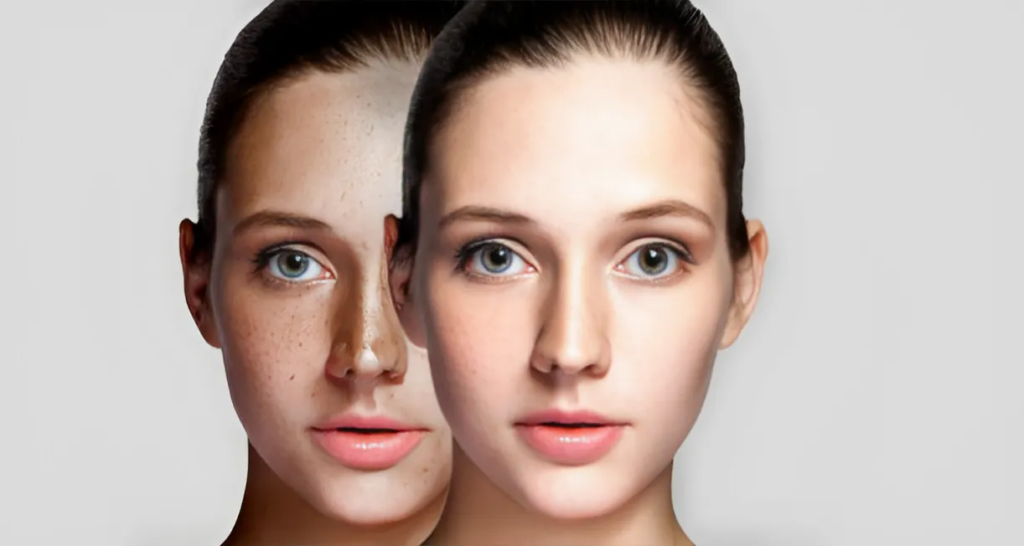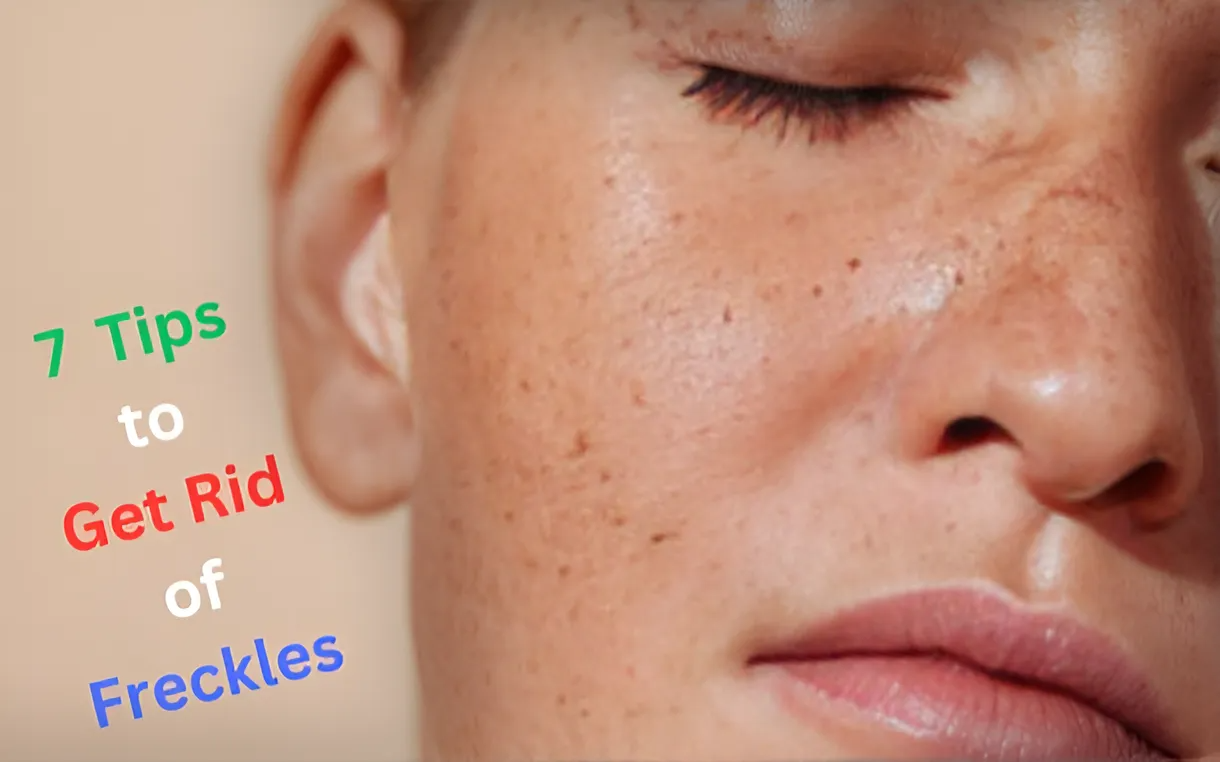Freckles, those tiny patches of pigmentation, can be endearing to some and a cosmetic concern to others. These small, flat spots, typically tan or light brown in color, often have a genetic predisposition but can also be influenced by exposure to sunlight. While many people embrace their freckles as unique features, others may seek ways to reduce or eliminate them. Understanding the nature of freckles and the factors that contribute to their appearance is crucial for those looking to manage them effectively.
What are Freckles?
Freckles are clusters of concentrated melanin, the pigment responsible for skin color, that appear as small spots on the skin’s surface. They typically develop in areas exposed to sunlight, such as the face, arms, and shoulders. Freckles are more common in individuals with fair skin tones due to their lower levels of melanin, which provides less protection against UV radiation. When the skin is exposed to sunlight, it triggers an increase in melanin production, resulting in the formation of freckles. These spots can vary in size and intensity, ranging from barely noticeable specks to larger, more prominent patches.
3 Different Types of Freckles
1. Ephelides
These freckles are often referred to as “sun freckles” and are typically small, flat spots that appear on areas of the skin that are regularly exposed to sunlight. They are usually light to medium brown in color and tend to fade during the winter months when there is less sun exposure. Ephelides are caused by an increase in melanin production in response to UV radiation, and they are more common in individuals with fair skin tones.
2. Lentigines
Also known as “sun spots” or “liver spots,” lentigines are larger and darker than ephelides. They develop as a result of prolonged sun exposure over many years and tend to be more persistent, often lasting year-round. Lentigines can vary in color from light brown to dark brown and may appear as flat or slightly raised spots on the skin. Unlike ephelides, lentigines do not usually fade with reduced sun exposure and may require professional treatment, such as laser therapy or chemical peels, for removal.
3. Café-au-lait Spots
These freckles are characterized by their light brown color, which resembles the shade of coffee with milk (“café-au-lait” in French). They are typically larger and more uniform in color compared to ephelides and lentigines. Café-au-lait spots often develop in childhood or early adolescence and may be present at birth. While most café-au-lait spots are harmless and do not require treatment, multiple or unusually shaped spots may indicate an underlying genetic condition, such as neurofibromatosis, and should be evaluated by a healthcare professional.
Causes of Freckles

- Sun Exposure: Freckles develop as a natural defense mechanism against the harmful effects of UV radiation from the sun. When the skin is exposed to sunlight, it produces melanin, a pigment that absorbs UV radiation and helps protect the skin from damage. However, in individuals prone to freckling, melanin becomes concentrated in certain areas of the skin, leading to the formation of freckles. Prolonged or intense sun exposure increases the risk of freckle formation, especially in individuals with fair skin, as they have less melanin to provide protection.
- Genetics: Genetics play a significant role in determining an individual’s susceptibility to freckles. Variations in genes responsible for melanin production and distribution can influence how the skin responds to sunlight and the likelihood of developing freckles. People with fair skin, red or blonde hair, and light-colored eyes are more genetically predisposed to freckles, as they tend to have lower levels of melanin, making their skin more susceptible to UV damage.
- Hormonal Changes: Hormonal fluctuations can also contribute to the development of freckles. During puberty, pregnancy, or hormonal therapy, changes in hormone levels can stimulate melanin production in the skin, leading to the formation of new freckles or darkening of existing ones. This is particularly common in individuals with fair skin or a genetic predisposition to freckling, as their skin may be more reactive to hormonal changes.
Prevention of Freckles
Sun Protection: The most effective way to prevent freckles is to minimize exposure to sunlight and UV radiation. This includes wearing protective clothing, such as wide-brimmed hats, long sleeves, and sunglasses, to shield the skin from direct sun exposure. Seeking shade during peak sun hours, typically between 10 a.m. and 4 p.m., can also help reduce the risk of sunburn and freckle formation.
Sunscreen Usage: Applying sunscreen regularly is essential for protecting the skin from UV damage and reducing the risk of freckles. Choose a broad-spectrum sunscreen with a high SPF (sun protection factor) of 30 or higher and apply it generously to all exposed skin, including the face, neck, hands, and any other areas prone to freckles. Reapply sunscreen every two hours, or more frequently if swimming or sweating, to maintain adequate protection throughout the day.
Avoid Tanning Beds: Tanning beds emit high levels of UV radiation, which can accelerate the development of freckles and increase the risk of skin damage and skin cancer. Avoiding tanning beds altogether is essential for maintaining healthy, freckle-free skin. Instead of indoor tanning, opt for safer alternatives such as self-tanning lotions or spray tans, which provide a tan appearance without harmful UV exposure.
Regular Skin Checks: Monitor your skin regularly for any changes in freckles, moles, or other pigmented lesions. Perform self-examinations at least once a month to check for new or evolving freckles, changes in color or size, irregular borders, or other signs of skin abnormalities. If you notice any suspicious changes, such as asymmetry, uneven coloration, or rapid growth, consult a dermatologist promptly for evaluation and possible treatment. Early detection and intervention are crucial for preventing skin cancer and maintaining healthy skin.
7 Proven Tips to Get Rid of Freckles

Lifestyle Changes
Making lifestyle changes can also support overall skin health and potentially reduce freckling. Eating a balanced diet rich in antioxidants, vitamins, and minerals can help maintain healthy skin and protect against sun damage. Staying hydrated by drinking plenty of water is also essential for keeping the skin hydrated and promoting cell turnover.
Natural Remedies
While not as potent as medical treatments, natural ingredients like lemon juice, aloe vera, and apple cider vinegar may help lighten freckles when applied regularly. These ingredients contain natural acids and antioxidants that can help exfoliate the skin and reduce pigmentation. However, it’s essential to use caution with natural remedies and discontinue use if any irritation occurs.
Sun Protection Strategy
Maximize your skin’s defense against harmful UV radiation by adopting two key practices. Firstly, apply broad-spectrum sunscreen with a high SPF to all exposed areas of your skin, particularly those prone to freckles. This proactive measure shields your skin from UV damage, thwarting further darkening or development of freckles. Additionally, strategically avoid outdoor activities during peak sun hours, typically between 10 a.m. and 4 p.m., when UV radiation is most intense. Seek shade whenever possible during these peak hours to minimize sun exposure and safeguard your skin from potential damage. By combining these preventive measures, you provide comprehensive protection against freckles and promote long-term skin health.
Makeup Tips for Covering Freckles
For those who prefer to conceal their freckles, using makeup can provide temporary coverage. Color-correcting concealers or foundations can help neutralize the appearance of freckles and create a more even complexion. Choose products with buildable coverage and blend them seamlessly into the skin for a natural-looking finish.
Topical Treatments
Creams containing ingredients like hydroquinone or retinoids can be effective in lightening freckles over time. Hydroquinone works by inhibiting melanin production, while retinoids promote cell turnover and fade pigmentation. These topical treatments should be applied consistently as directed by a dermatologist to achieve optimal results.
Laser Treatments

Laser therapy is a popular option for targeting and reducing the appearance of freckles. Laser treatments, such as intense pulsed light (IPL) or fractional laser resurfacing, work by targeting melanin in the skin and breaking up pigmentation. Multiple sessions may be required for significant improvement, and it’s essential to undergo treatment from a qualified dermatologist or skincare professional.
Dermatologist Recommendations
Consulting a dermatologist is crucial for personalized treatment options tailored to your specific skin type and concerns. A dermatologist can assess your freckles and recommend the most effective treatments, such as prescription-strength creams or procedures like cryotherapy (freezing the freckles with liquid nitrogen).
In a Nutshell
In summary, freckles, influenced by genetics and sun exposure, prompt individuals to seek effective management strategies. Understanding their causes, including sun exposure, genetics, and hormonal changes, underscores the importance of sun protection and lifestyle choices. Treatment options, such as topical creams, laser therapy, and dermatologist recommendations, offer avenues for reducing their appearance. By prioritizing sun protection and embracing personalized treatments, individuals can confidently manage their freckles and maintain skin health.


